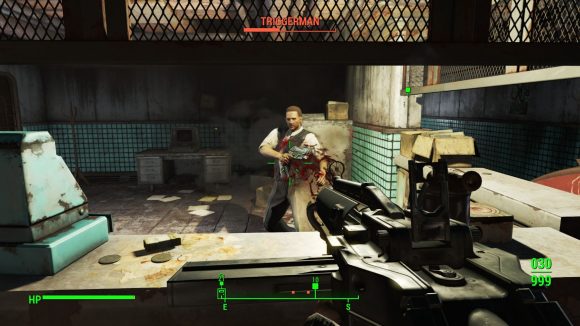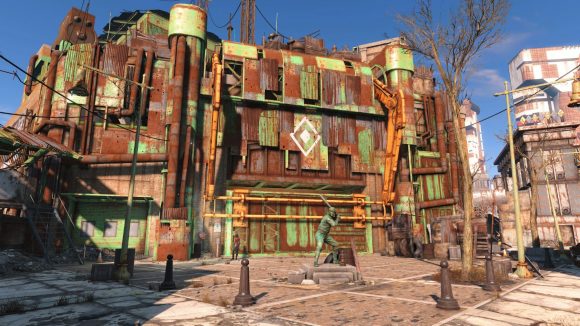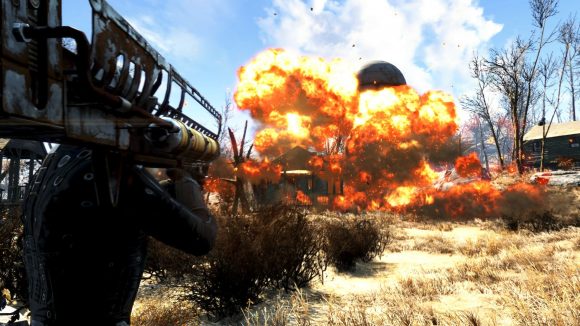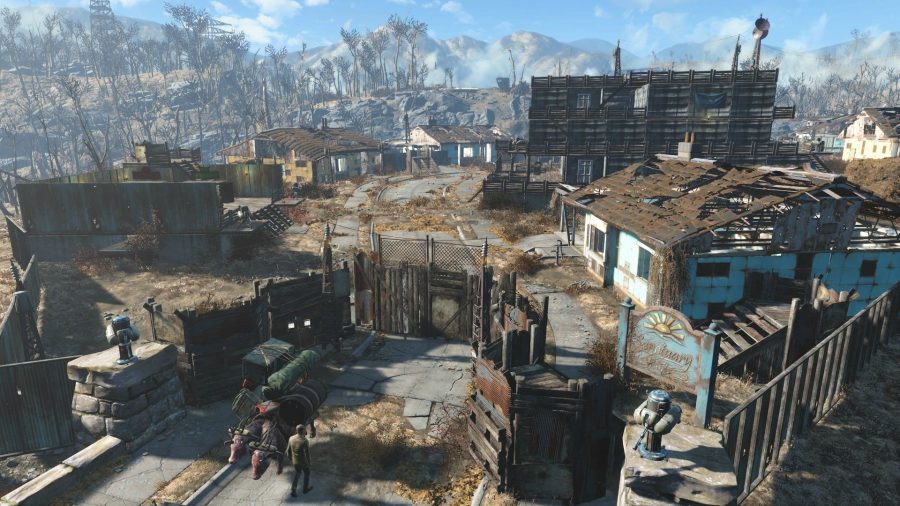Our Verdict
The overfamiliar flavour may mean Fallout 4 doesn’t quite stand tall, but it does mean you can guarantee what you’re getting, and that’s a damn fine game.
Fallout 4’s world is full of survivors and scavengers desperately clinging on for dear life. Using the remains of technologies from the past, they bolt things together to create machines that are just about improvements on what came before, and that’s considered progress. In many ways, that’s also Fallout 4.
While there’s a brand new engine rumbling beneath its newly painted bodywork, the pieces that fit together to make this behemoth of a game are distinctly familiar. There are a few new features that stand out like shiny chromed components, but from moment to moment Fallout 4 feels like its two modern predecessors: vast, packed, quirky, and held together with nails and duct tape. Fallout. Fallout never changes.
Fallout 4 transports us to Boston, 200 years after nuclear war devastates the United States. In a new move for Fallout, the prologue shows us pre-war America in its 1950s-style retro-future glory. It’s here that you’ll be introduced to your character: a husband or wife who has recently started a family, and has hopes and dreams still to live. The diverse character creator lets you craft your face in the bathroom mirror, before quickly whisking you to the underground Vault 111 because pesky nuclear war breaks out.
Unlike Fallout 3, which took place in the vault for literally your entire childhood and young adult years, Fallout 4 just gets on with post-apocalyptic life. Within half an hour the giant blast door has rolled aside and you’re out in the wastes, ready to embark on your adventure. It would be a shame to spoil here what your motivations for getting into the outside world are, but events in the vault mean you have a distinct, personal mission to pursue.
Post-war Boston is a gorgeous, hand-crafted world that feels like an actual place as opposed to a videogame map. A lot of this comes down to its use of real landmarks. You’ll see the likes of the Paul Revere Monument, the Massachusetts State House, and the USS Constitution on your travels, which help cement the world of the Commonwealth as a genuine place. Houses and structures look unique and are laid out in a realistic fashion, which prevents the copy-and-paste look that destroys the atmosphere in so many urban-set game worlds. Beyond the city limits, creepy fields of dead tree stumps and collapsed highways stand out among the wreckage. It’s a far more colourful landscape than we’ve seen from Fallout before, which makes it feel both exciting to explore and less visually exhausting. Out with the flat, greenish grey hue. In with vibrant, beautifully lit vistas.
Weather can’t be understated when it comes to making Fallout 4’s world feel special: radiation storms brew and fill the skies with green forked lightning and swirling clouds of nuclear fire. The wind howls, the Geiger counter clicks wildy. The best place to experience it is the Glowing Sea: a crater where one of the bombs hit, it’s now the eye of a perpetually raging storm. Passing through it is like a sci-fi variant of Lord of the Rings’ Mordor. It’s wonderfully terrifying.
This world is made even more special by the impact you have on it. And I’m not talking about what decisions you make with its cast of characters and factions, but the actual visual changes you can make. Fallout 4 is a game about rebuilding. When you help towns and outposts out, you gain access to their workbench. From here you’re granted a radius of workspace, where you can build housing, trading posts, farms, wells, and other life-sustaining structures.
Feed scrap into the workbench, and you’ll be able to break it down into the raw materials needed to make a water pump, a bed for people to rest in, or the walls needed to erect a new shack. It’s the most compelling new addition to Fallout 4 because it’s Sims-like in its depth and execution: you can build houses to your exact specifications, and furnish them with sofas and lamps. Rig up some generators and bring power to your new little village. And then set up machine gun turrets to keep raiders away. Spending hours cleaning up areas and improving the living conditions of your survivors offers a real long-term alternative to questing, and also makes picking up all the junk Fallout so frequently offers an absolute necessity.
So who are the people you’ll be helping? Your first meeting will be with The Minutemen, a struggling group that are basically a Boston-wide neighbourhood watch. They just want to get out there and do good, and by helping them you’ll begin to make a solid foothold on the places you can claim in the wasteland. Naturally the Brotherhood of Steel are in town (watching over it from a humongous airship), and you’ll see them frequently swooping around in vertibirds, peppering targets below with minigun fire. Search deeper underground, and you’ll find the likes of the Railroad, a secretive human rights group.
None of the groups are portrayed as good or evil, and the karma system has been scrapped, so it’s all down to what you agree with and feel most comfortable pursuing. Their goals do conflict though, so as time goes by you’ll need to pick a side, and deal with the consequences of doing so.
The one thing they all share in common though is a distrust of The Institute. It’s a name uttered in hushed tones with twisted lips; the entire population of Boston either hate it or fear it. Responsible for synthetics – robots who have now reached such stages of advancement that they’re indistinguishable from humans -The Institute has been kidnapping people and replacing them with synths, leading to high tensions and constant paranoia. Early on you’ll bear witness to a man being held at gunpoint as people shout and scream that he’s not real. It’s oddly affecting, and sets the scene for what is the most unsettling Fallout story yet.
On your travels you’ll bump into a variety of synths, mostly of older Terminator-style skeleton design with popping eyes and clenched jaws. They’re a welcome addition to a huge variety of enemies that still includes super mutants, raiders, rad scorpions, and the mighty deathclaws. Each and every one can be blown to smithereens with anything from nukes to teddy bears. The absolute biggest praise I can offer Fallout 4 is just how far combat has come since the clunky, barely functioning Fallout 3. You can – and almost certainly will – play the game as a shooter. Firing from the hip and through sights feels indistinguishable from the best FPS games, and is entirely preferable to the slow-motion VATS targeting system.
Fallout 4’s shooting isn’t just functional now, it’s exciting. Combat feels far more alive and dynamic. The camera shakes and blurs with explosions. Huge bosses can shoulder barge you out the way. Enemies dive and grab at you, and will duck out the way of your fire. Missions have a few scripted sections that help the game feel more cinematic. A battle through a high-rise facility, where soldiers constantly fire rockets into stair wells and turrets pound lasers without pause, is like a sequence from the movie Dredd. It’s one of Bethesda’s best RPG games, and the most involving one yet.
Notable in how Fallout 4’s combat works is armour. Power armour is an iconic part of the series, and it’s been completely rethought this time around. Rather than being a suit that you buy and wear like clothing, it’s now essentially a mech that you wear over your existing apparel. It’s made up of a frame that you affix armour plates to, and when you mount up you’ll be able to withstand much more damage, be immune to radiation, and carry more.
To make the suit feel more mech-like in its design, not only does suiting up make you taller, stompier, and give you a new HUD, but power armour also requires fuel. Just walking around in it uses up fusion cells at a not-inconsiderable rate, so you constantly need to be on the lookout for batteries should you wish to be strapped in permanently. Your armour is very much your own, and can be painted with your prefered design to shout out your allegiance, and modified with a bunch of cool additions (including a jetpack).
Related: How to use Fallout 4 console commands and cheats
Weapon modification is where it gets really interesting though. Fallout 4 has an uncountable amount of weapons that can be created from a selection of base designs. For example, a laser gun can become a laser rifle with a big stock and long barrel, or an automatic laser pistol by attaching a rotary muzzle and short grip to it. Every weapon can have its receiver, barrel, sights, and grips modified, allowing you to create a gun for every occasion and situation. Along with the outpost construction mechanics, it’s the depth of crafting that really makes Fallout’s scavenging gameplay so worthwhile. And like in Skyrim, there’s a crafting station for everything, from cooking to chemical production.
Evidently there’s a lot to love here, and if you enjoyed the previous two games you’re going to have an absolute blast. But there are a number of elements that hold Fallout 4 back from being a masterpiece. Most relate to overfamiliarity: beyond the new crafting mechanics, map, and story, the game itself doesn’t feel exactly advanced. Mission design is mostly identical to Fallout 3, with a lot of ‘go here and clear out the raiders’ objectives that do little to disguise the simplicity of the task. Compared to the likes of The Witcher 3, which has demonstrated how to do incredible mission design that weaves interesting tasks with exceptional narrative progression, Fallout 4 feels quite archaic. There’s nothing inherently wrong with partying like it’s 2008, but I expect more ambition from a studio like Bethesda.
Talking of feeling like 2008, there’s also a lot of old-hat design when it comes to technology. The game still has to load at almost every main door in the game, which means once again you’ll be spending considerable time starting at loading screens. Streaming technology has come on in absolute leaps since both Fallout 3 and Skyrim, so it feels positively ancient to have to do this amount of waiting around just to pop in and out of a building. There’s even a slight load delay on using magnified scopes, as it fades the screen to black before showing your zoomed view, which makes the game feel both dated and awkward.
Looking at the screenshots in this review, you’ll have noticed something fairly obvious: Fallout 4 isn’t a visual masterpiece. It certainly looks like a game made seven years after Fallout 3, but when Fallout 3 was released it already looked two years old. As such, textures range from fine to abysmal, with muddy colours and no definition. Human character models look like waxworks, while some non-humans look like paper mache monstrosities with bumps caused by jagged polygons and a blurry look thanks to the low resolution of the texture work. Thankfully the art direction leans towards being a little cartoony, so the flatter colours and simpler model work doesn’t look entirely out of place. The big saving grace though is the lighting, which is genuinely superb, with spectacular usage of volumetric effects. This overrides most of the problems and prevents the game looking ugly.
Lighting can’t save the animation though, which feels as if it was motion-captured from the Thunderbirds marionettes. Characters move awkwardly, pausing between animations, and generally feeling like robots. This certainly doesn’t help to hold up the paranoia of everyone being potentially a synthetic. And then there are still horrible hangovers from the previous generation of Bethesda games: when NPCs use a door, they still do that thing of reaching for the door handle, and then fading away. Why in 2015 can’t they just walk through the door? It’s truly illusion-shattering.
There’s not quite as many bugs as we’re accustomed to in a Bethesda launch, but you’ll still see things going awry. Over the course of my journey, a companion got himself stuck on a roof and couldn’t get down. An NPC strapped on power armour, and the armour disappeared to reveal the character inside, now stretched like Mr. Fantastic to fit the proportions of the suit. During a notably difficult boss battle, a key character ran off, and when I went to hand in the quest I found him several miles away. I had to wait for him to walk back to the quest location before I could progress to the next objective. I’ve found nothing game-breaking, but there are occasional irritants.
As for PC options, don’t get excited. The in-game menu offers barely anything beyond some basic customisation of HUD colour and crosshairs. Main graphic adjustments have to be made from the desktop launcher, which allows you to set resolution, antialiasing, anisotropic filtering, and graphical presets ranging from ‘low’ to ‘ultra’. Advanced options allow you to adjust quality on the typical range of textures, draw distances, and ambient occlusion. Its main crime is that there’s no FOV slider, which means playing at the typical console levels that force your guns and HUD to occupy a vast amount of screen space.
More like this: Here are the best Fallout 4 mods
I reviewed Fallout 4 on a PC rig powered by an i7 3770k 3.5ghz CPU, 16GB RAM, and an ATI Radeon HD 7970. Performance at ultra settings is generally fine, with a framerate of 60 being very achievable. It’s not a stable framerate though, and will bounce and vary. Other than a single instance of it dropping to 15fps, I found it mostly held between 45 and 60, and never felt unplayable or too intrusive. Ultra textures are somewhat better than the other settings, but don’t expect to be blown away. There’s also frequent and very noticeable texture pop-in.
The lower-than-anticipated graphical quality and sometimes iffy performance is a bit of a blemish on the experience, but Fallout 3 suffered similarly and still achieved greatness. And while Fallout 4 hits all of its predecessor’s high notes and even a few of its own, it’s because of how precisely it mirrors Fallout 3 that causes it to miss out on being a new legend in its own right. New Vegas feels like it will constantly play second fiddle to Fallout 3 because of how similar they are (it could even be considered a standalone expansion). Fallout 4 isn’t quite like that, but feels more like the kind of sequel that would be produced two years later rather than seven. It’s the wait that’s arguably damaged it the most: expectations may have been built too high.
Its combat is the best Bethesda have ever produced: involving, kinetic, and exciting. The collection of weapons at your disposal are destructive and inventive, and strapping on power armour makes you feel like an absolute killing machine. Plenty of the missions are rote, but the narrative is the best Fallout has seen, and the factions you interact with seem more complex and multi-layered than ever. There’s enough choice to make at least two playthroughs worth it, meaning this is a game with over 100 guaranteed hours of compelling play in it. With a menu like that, chances are you won’t care about the blemishes and deja-vu. You’ve been happily drinking classic Nuka-Cola for years, so why would you want a changed recipe now?
























